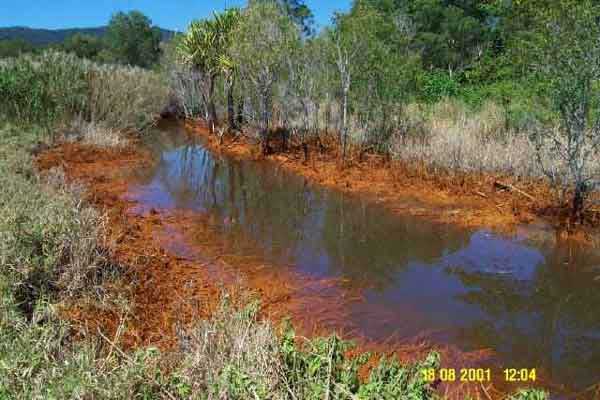Coastal waterways with tributaries that drain through acid sulfate soils (ASS) are at risk for acidification.
The percent of catchment river length draining ASS in Australia’s Intensive Landuse Zone was used as an indicator in the assessment catchment condition, during the National Land and Water Resources Audit 1. Acid sulfate soils were defined as soils having a pH of 4.8 or less 2.

Photo 1. Iron staining is often a good indicator of disturbed acid sulfate soils. When acid sulfate soils are disturbed and undergo oxidisation, the sulfuric acid produced mobilises iron, aluminium and heavy metals present in the soil. Toxic amounts of dissolved iron can then be washed into waterways. This iron can precipitate when in contact with less acid water, such as rainwater or seawater. This results in a rust-coloured iron oxide scum or ‘floc’ which can smother vegetation and stain concrete and soil. (‘QASSIT, Qld Department of Natural Resources and Mines’).
Coastal issues arising from rivers in acid hazard
The disturbance of ASS for agriculture, urban development, flood mitigation and other land uses can expose iron sulfides to air. When pyrite is oxidised (pyrite oxidation), a cocktail of sulfuric acid, aluminum, iron, and other metal contaminants can move into coastal waters, potentially causing:
- anoxic & hypoxic events;
- fish kills; and
- an overall reduction in biodiversity.
Existing information and data
More information and maps showing ‘rivers in acid hazard’ can be found at the Catchment Condition Online Maps website 1. Appendix I (pp. 311-312) in Volume 2 of the Australian Catchment, River and Estuary Assessment, 2002 contains a map of Australia’s River Basins and Drainage Divisions in which each river basin has been assigned a number. These catchment numbers can be matched to a large number of coastal waterways in pages 316-363 of the same document. The ‘rivers in acid hazard’ scores for a large number of river basins are available in Appendix B (pg 65-76) of the Assessment of Catchment Condition in Australia’s Intensive Land Use Zone: A biophysical assessment at the national scale 1.
- The assessment of catchment condition was conducted as a partnership between the Audit, the Bureau of Rural Sciences and CSIRO Land and Water with support and involvement of State and Territory natural resource management agencies. The final report (Project 7/8) to the National Land and Water Resources Audit by Walker, J., Veitch, S. Braaten, R., Dowling, T., Guppy, L., Herron, N (2001) is entitled Assessment of Catchment Condition in Australia’s Intensive Land Use Zone: A biophysical assessment at the national scale and is found at the following website Assessment of catchment condition in Australia’s intensive land use zone : a biophysical assessment at the national scale / Joe Walker, Simon Veitch. ↩ ↩ ↩
- Catchment Condition Online Maps website at Department of Agriculture and Water Resources. ↩


